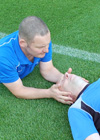Preface
Injuries are a part of any contact sport. Serious or life threatening injury in Rugby is, however, rare. The outcome of many injuries can often be improved by very simple first aid skills from bystanders until emergency help arrives.
Planning for such events can make a situation less stressful for all involved and help co-ordinate safe and effective care from the initial injury through to final treatment, which may be in the medical room at the venue or on transfer to hospital.
Experienced players or those who are “fitter” may be more resilient to not sustaining a game ending injury. Conditioning or injury prevention initiatives such as the World Rugby Strength and Conditioning programme, Rugby Ready resource, Activate, Tackle Ready and Breakdown Ready may help protect players from injury.
Injuries will, however, still occur, and for the majority of the Rugby-playing world there is little qualified medical support available pitch side. Thus, first aid responsibility may fall to bystanders until more experienced medical support arrives. Such bystanders may be parents, club officials, coaches, referees or even other players.
This online course is designed for club staff, coaches, referees and parents as a sports first aid course for Rugby Union, and is a pre-requisite for anyone attending the World Rugby Level 1 First Aid in Rugby course.
It is the intention that through this course there will be a significant improvement in the provision of first aid to our players, facilitating not only a reduction of complications of injuries, but also a rewarding satisfaction providing confidence through a competency assessment process to the providers of this care.
Five steps to Player Welfare
World Rugby has developed a three-tiered medical education programme relevant to the immediate management of Rugby injuries for all levels of the sport. You can view the World Rugby face-to-face, medical education courses here: World Rugby Passport - Face-to-face courses and accreditations
The tiers are built around the five key messages relating to potentially serious injuries in Rugby. Download the World Rugby Five Steps to Player Welfare in Adobe PDF format

Be a lifesaver; know your S-A-B-C
- S:Safety, A: Airway, B: Breathing, C: Circulation
- Saving a life always starts with safety then airway
- If you don't have an A you won't have a B or C
- Airway: open it, clear it, maintain it

If they are on the deck, think about the neck
- Don't shake them, don't roll them, don't sit them up
- Think about the spine, keep it in line and take your time
- Stop the game and ask about pain
- An unconscious player has a neck injury until proven otherwise

Train to prevent injuries
- Don't suddenly change your training
- Protect players returning from injury - they are at increased risk of injury
- Undertake high risk training (contact, sprints) at low risk times (when not fatigued)
- Injury prevention: it's in the balance (exercises)

Tackle concussion
- Don't lose your head, read the signs instead
- Concussion makes no sense - a concussed player may be confused - they are at increased risk of harm and should be removed from the game
- Recognise and remove - if in doubt, sit them out
- Don't risk your brain to win a game

Kick infection into touch
- Don't share your blood on clothes and towels; blood spreads infection; wash it or dispose of it
- A wound neglected is a wound infected
- The solution to pollution is dilution - wash the wound with large amounts of water
- Clean it, then cover it
Acknowledgements
The commitment to the task and efforts of the author and the consultancy team in contributing to the development of this educational programme are gratefully acknowledged.
- Authors – Jonathan Hanson (SRU), James Robson (SRU)
- Editor – Mark Harrington (World Rugby)
- Consultancy Team – Andy Smith (World Rugby), Brian Carlin (IRFU, SRU), Omar Hassanein (IRUPA), Martin Raftery (World Rugby), David Owens (HKRFU) and Warren McDonald (ARU)
The author, editors and World Rugby would like to express their gratitude to the American Heart Association (AHA), European Resuscitation Council (ERC) and Australian and New Zealand Committee on Resuscitation (ANZCOR) for their kind permission to reproduce their algorithms in this text.
- American Heart Association (AHA): https://cpr.heart.org/en/resuscitation-science/cpr-and-ecc-guidelines/algorithms#adult
- European Resuscitation Council (ERC): https://www.anzcor.org/
- Australian and New Zealand Committee on Resuscitation (ANZCOR): https://www.erc.edu/